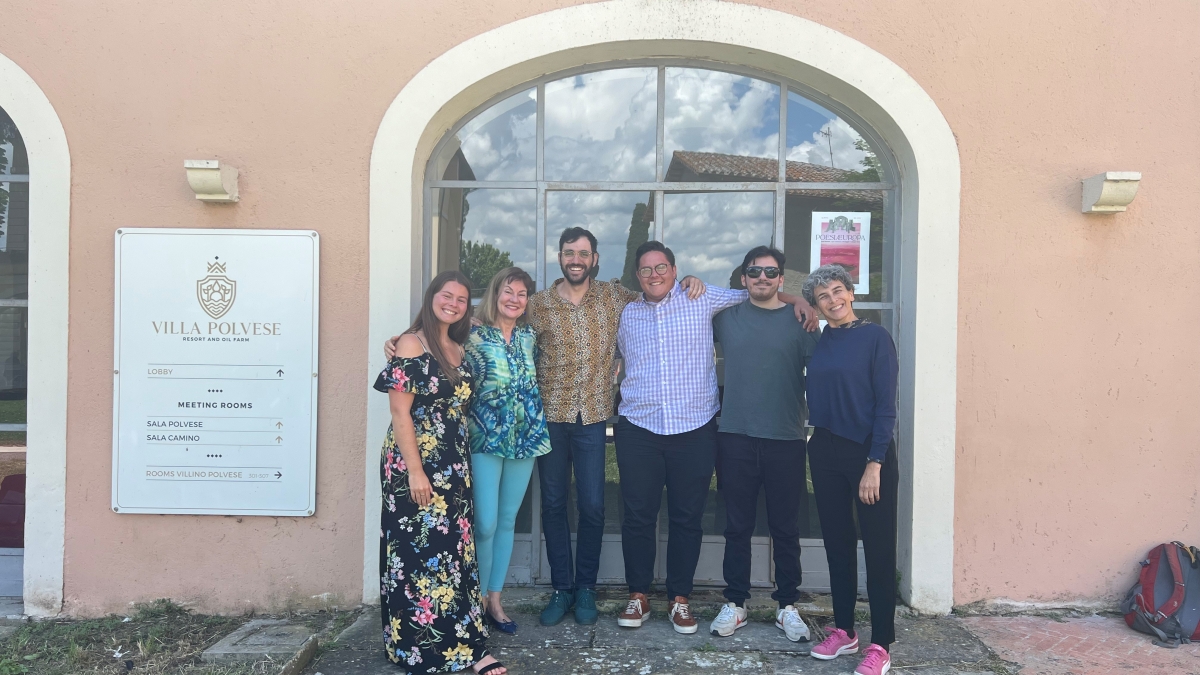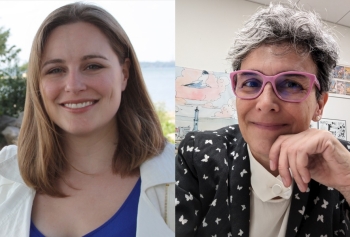ASU professors discuss evolving relationship between poetry and technology

Serena Ferrando (far right), an assistant professor of environmental humanities and Italian in the School of International Letters and Cultures, poses with five ASU fellows at the international literary conference Poesiæuropa, held on Polvese Island, Lake Trasimeno, in Italy. Courtesy photo
Sonnet, ode, haiku.
National Poetry Month.
TikTok, Italy.
Ordained as National Poetry Month by the Academy of American Poets in 1996, April is a time to celebrate and reflect on the creative medium’s impact on our culture.
Poetry, like other mediums of artistic expression, has been impacted greatly by technology, with innovations like artificial intelligence and social media making it more accessible to the masses. But how does the fluctuating technology landscape change our relationship with poetry? Two professors in The College of Liberal Arts and Sciences at Arizona State University have some insights into this question.
Sarah Florini is an associate professor of film and media studies in the Department of English and the interim director of the Lincoln Center for Applied Ethics, home to the Digital Humanities initiative. Her 2019 book “Beyond Hashtags: Racial Politics and Black Digital Networks” explores how Black Americans use digital mediums to organize and cultivate relationships with their community about larger social issues.
Serena Ferrando is an assistant professor of environmental humanities and Italian in the School of International Letters and Cultures. Ferrando is involved in the international literary conference Poesiæuropa, held on Polvese Island, Lake Trasimeno, in Italy. This year's conference, set to take place in June, will explore textuality and technology, literature and science fiction, and writing between violence and peace.
Here, the duo discuss the role technology has on poetry and how social media has impacted poetry consumption and creation.
Question: How do social media platforms become platforms for artistic expression or the creation of poetry?
Florini: First, before we talk about creativity on social media, we need to recognize that social media platforms are owned by corporations. Everything about them is shaped by the economic imperative to monetization. What’s happening on these platforms, in terms of creativity, (it is not there) because of the platforms, but almost in spite of them. People are taking the space that is available to them … and working within that platform to often do amazing and creative things.
Users are actively negotiating and playing with the affordances of the platform.“Affordances” are the characteristics that enable and constrain certain kinds of uses. Twitter (content) used to be short. You had 140 characters, which was a certain constraint. Then the use of hashtags led to short, pithy wordplay and the creation of a sort of punchline type of culture.
Ferrando: Technology has made it possible to engage students in the wider, worldwide community more. For example, geographical information systems (GIS) and social media allow students who are interested in poetry to participate in conversations about poetry and environment or in poetry events overseas. It is absolutely fantastic.
I embrace AI in my courses. It’s difficult to fight it at this point, so we might as well include it — even if as co-author. My students are free to use AI in my digital humanities courses to create the materials that we explore in class. For example, in the last edition of the course, “City of Water,” students utilized AI to recreate photographs of deceased Italian poets in current urban landmarks as a way of showing the permanence of their work in today’s cultural landscape. Other students asked AI to write a musical composition around beloved (Italian poet) Alda Merini’s work.
Q: Ferrando, can you elaborate on poetry’s role in your native Italy?
Ferrando: Italians, in general, love to read and write poems. Four out of 10 Italians write poetry at some point in their lives, and many more purchase poetry books. In my courses, we look through an eco lense at the relationship between literature and the environment. In the case of Milan, which is a landlocked city, we pay attention to the presence of water in the local poetry, which echoes the city’s existential thirst following the covering of many of its water canals.
For example, Merini lived by a small section of a remaining canal and often mentioned it in her work. Younger generations that have never seen the canals but read about them in her poetry want to recover that connection with water that the city has lost and, for this reason, support local initiatives for the reopening of Milan’s waterways.
Q: How does social media shape the poetry community?
Florini: Because of the different affordances, you get different genres that develop on different platforms. Vine, for example, developed a short comedy genre, but Youtube facilitates long form, so you get video essays. If we want to expand the definition of poetry beyond written word and include the use of artistic visuals like Instagram, users can edit and put effects to videos in ways that people can get creative.
Even within the constraints, users are going to make platforms do what they want them to do and figure out how to use those tools to express themselves.
Ferrando: Technology gives us the opportunity to take poetry to places where it wouldn’t normally be. It gives us the opportunity to get poetry involved in civic and social conversations about sustainability and the environment and to disseminate the message of poetry to people who normally would not be reached through more traditional media.
Q: How has technology changed the poetry writing or creation process?
Florini: One of the major things that people are doing on social media is creating and consuming educational content about art and literature. I’m doing research on TikTok right now, and there’s what’s called BookTok, where people read and discuss a variety of literature. This leads to creative experimentation. There’s a phenomenon that’s called “remediation” where people take a piece of media — like a novel or a poem — and transform it into a new medium. The algorithmic curation of content creates a nonlinear storytelling that gives things to people in snippets.
There are a lot of examples of people doing everything across the board from just “I’m going to make a Twitter thread about my favorite novel or poet” to “I’m going to remediate, reimagine and retell these stories.”
Ferrando: We can continue to use different tools and different strategies, but the core of poetry is always the same, which is to try to surpass our limitations of being human. I think that’s one of the reasons behind technology, too. It’s this idea of pushing ourselves further and to increase the abilities and capabilities of humanity to achieve or learn. In that sense, technology is connected to poetry because it stems from the same desire to transcend our perceived limitations.
More Arts, humanities and education

Behind the curtain: Discovering careers in the arts at ASU Gammage
For a group of students from Sunnyslope High School, Eastmark High School and AZ Teen Homeschool Co-op, a recent December day at ASU Gammage became much more than just a field trip. It became an eye-…

Honoring a legacy of cultural education, exploration
Belle Edson has inspired countless students to expand their horizons during her 26-year tenure at Arizona State University. A beloved professor and director of undergraduate studies and core courses…

School of Social Work’s ‘keepin’ it REAL’ substance use prevention program to expand across Sonora this spring
More than 7,000 seventh graders in the Mexican state of Sonora will enroll this spring in an Arizona State University program that has been teaching how to prevent substance use to thousands of…
